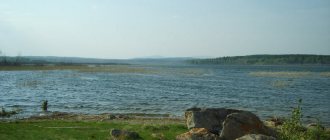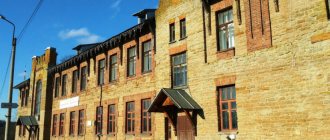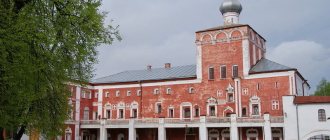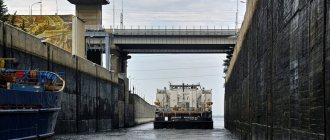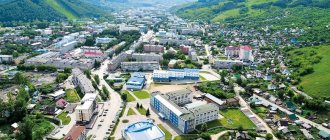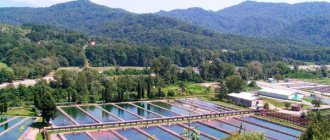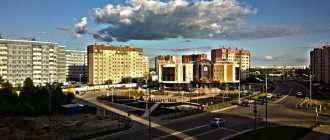Lake Chebarkul, located in the Chebarkul district of the Chelyabinsk region, became known to the whole world after the event that occurred on February 15, 2013. On this day, a meteorite fell into the reservoir, which was later named Chelyabinsk.
Dimensions of the reservoir: length - almost 6 kilometers, width - 5.1 kilometers. The average depth of the reservoir is 6 meters, the maximum can reach 12 meters.
© Ruslan Garipov
Chebarkul Church of the Transfiguration of the Lord
On the site of the old destroyed church of the 19th century, a new Church of the Transfiguration of the Lord appeared. It is located in the western part of the city on Pushkin Street, 24.
The history of the old Chebarkul church is connected with the uprising of Emelyan Pugachev. It burned down in 1775 after Pugachev’s retreat. In 2007, a new creation appeared on this site, which retained the style of its predecessor.
The Church of the Transfiguration of the Lord is a temple with five domes and six pillars with porches. There is also a high bell tower, which looks like an open gallery from the inside.
Peculiarities
It is known that the first settlements in these places appeared in the 4th century BC. Archaeologists have discovered several sites of ancient people on the shore of the reservoir. In 1736, the Chebarkul fortress was built on the eastern bank.
During the Pugachev uprising, the fortress was partially destroyed, but it was restored two years later. Over time, the city of Chebarkul was founded on this site.
Scientists believe that the age of the lake is more than 10,000 years.
The banks of Chebarkul are rocky, uneven, and there are wetlands. In some places the land protrudes significantly, forming small peninsulas. Due to such an indented coastline, several backwaters and bays have formed, which are called Kuryas. On the reservoir itself there are several islands - Razboinichiy, Krutik, Two Brothers, Maryin, Kopeika, Korablik, Golets, Sosnovy, Lipovy.
The name Chebarkul is translated from the Bashkir language as “beautiful lake” - and for good reason. The shores here are truly picturesque. An incredible view opens from Cape Semerik, from the islands of Two Brothers, Kopeika and Sosnovy. Tourists and locals love to relax on the shore of the reservoir. It is especially crowded here from late May to October. During the season, by the lake you can not only enjoy the extraordinary nature, but also relax on the beach, and pick berries and mushrooms in the forest.
In winter, by the way, tourists also like to relax here: at the tourist centers you can find various entertainments, and on the lake itself (in safe places) sometimes there is an ice skating rink.
© Ruslan Garipov
Lower Church of the Transfiguration of the Lord
One of the most beautiful temples is the Lower Church of the Transfiguration of the Lord. Construction of the temple took about three years. It is also known that about 55 million rubles were spent on the construction of the temple. Moreover, most of the amount was donated by parishioners.
The temple began its existence back in 1475. It was built during the founding of the Chebarkul fortress.
On every Christian holiday, the church is consecrated here. Consecration is one of the greatest events in scripture.
Temple in honor of the Holy Martyr John the Warrior
Currently, this temple is located in a railway carriage. On the trailer there is an onion with a cross. Not far from the trailer there is a banner depicting a church in the future. This temple began its existence in 2007. Today the temple is equipped with an iconostasis and icons are hung.
Location: 40 Let Pobedy street - 31B/3.
Historical and cultural regional museum named after Gerasimov
This museum is dedicated to one of the most outstanding film directors Sergei Apollinarievich Gerasimov . The museum is directly connected with the life of the talented director. In the museum you can see what the furnishings of Gerasimov’s office looked like, as well as his library, certificates of honor and diplomas.
Many tourists come to see the same Gerasimov cane that was given to him by Charlie Chaplin himself. They were very close friends.
There is also a small corner in the museum that is dedicated to Makarova. T.F., the director’s wife. Many of her awards and some personal items are here.
Chebarkul Victory Park
Victory Park is located on the street. Lenin. The founding date of Victory Park is 1967. There is a monument dedicated to the Chebarkul warriors in the park. This monument was the reason for the founding of Victory Square. Currently, the reconstruction in appearance resembles a special memorial complex. There is also a memorial wall here. The names of the fallen Chebarkul residents who gave their lives for Victory in the Great Patriotic War are engraved on the memorial wall.
Today it is a recreation park. The park is surrounded by evergreens, and a children's complex is located in the corner. The park is very colorful and elegant, which attracts many tourists.
Chebarkul city
Chebarkul , city, administrative center of the Chebarkul district and Chebarkul urban district. Located in the central part of the Chelyabinsk region, 78 km west of Chelyabinsk, on the shores of Lake Chebarkul (hence the name). From 12 Jan. 1965 Chebarkul was given the status of a city in the region. subordination, in 1996 - cities of the region. meanings.
Population 47.1 thousand people. (in 1900 - 1945, in 1959 - 31 thousand, in 1979 - 45.8 thousand, in 1995 - 51.6 thousand).
Local self-government is carried out on the territory of the Municipal Municipality “City of Chebarkul”. Introduce organ - mountains collection dep. (25 people, since 2005 chaired by V. G. Fakhurov) - elected for 5 years. Executive-manager. functions are performed by the district administration (since 2005 it has been headed by G.F. Severin). OK. For 30 years, the emblem (author V. Klementyev), approved, was used as the coat of arms of Chechnya. by decision of the executive committee of the Chebarkul City Council, dept. July 23, 1974. The official symbols of Chebarkul - the coat of arms and flag - were approved by the decision of the Chebarkul city. collection dep. No. 215 from October 1. 2002; included in the State. heraldic register of the Russian Federation (No. 1090 and 1091, respectively).
The coat of arms was designed by the Chebarkul art museum. E. Korolkov (idea) and the Moscow group. heraldists: K. F. Mochenov (heraldic revision), G. A. Tunik (substantiation of symbolism), S. A. Isaev (computer design). Description; “In a scaly, intersected silver and azure (blue, light blue) field, there is a golden field with four bastions (two and two), a fortress shown from above, filled with greenery, inside of which there are five golden triple leaves of strawberries (one, two and two), connected in a ring by forked stems outward” (see color insert). Basic the figures of the coat of arms are a fortress with 4 bastions (a symbol of foresight, protection from any attacks) and triple strawberry leaves, compound. ring (fertility, growth, renewal, unity, continuous movement of life) - and the color scheme characterize the city as the center of the Chel resort area. region Gold represents wealth, justice, dignity; the silver field allegorically conveys a favorable climate, symbolizes purity and sincerity; the azure part (greatness, beauty, virtue) indicates the lake. Chebarkul with its many. radon sources; azure - truth, honor; green is the color of nature, a symbol of hope and prosperity.
The flag is a rectangular panel with a width ratio. to length 2:3, scaly section. horizontally on white and blue stripes; in the center of it are reproduced figures from the city's coat of arms.
Nature . Ch. is located on the eastern slopes of the Ilmen Mountains. To the north-west from it there are lakes. Elovoe and Bolshoi Kisegach, to the north - Bolshoy Bolyash, to the north-east - Misyash. Landscape - subzone of pine-deciduous forests; to the southeast there is a forest-steppe with ribbon pine forests. In the vicinity of the city there is Chebarkulsky Bor, a natural monument. The writer M. S. Shaginyan pointed out in her travel essays: “The beauty of these places can only be seen by getting off the train at Chebarkul station and traveling around a dozen lakes and its surroundings. Here is Chebarkul Lake itself, lead-gray, with marshy shores, in a dense forest, transparent as glass, Spruce Lake with marvelous swimming, further away - in a light deciduous grove, pale blue, the color of forget-me-nots, small lake Tabankul...”
Story . Chebarkul is one of the few. cities of the Chelyabinsk region with a centuries-old history. Petitions are stored in the archival funds. various settlements that asked for permission to move to a new region abounding in lakes (“pleasant places, strong for settlement”). The earliest is dated 1695, addressed to Tsar Ivan V Alekseevich and his younger brother Peter I. Local historian N. Chupin in Yekaterinburg. A petition from the peasant S.I. Kuznetsov from the village was discovered in the archive. Uksyansky Krutikhinskaya village (its full text was published in the book “Materials on the history of the Bashkir Autonomous Soviet Socialist Republic”, vol. 3, no. 547), who visited the lake. Chebarkul in 1728. He attached a plan of the future construction site to the petition. The book also contains the contents of the Senate decree: “... Having listened to Stepan Kuznetsov’s petition sent from the Supreme Privy Council of the Siberian province of Krutikhinskaya Sloboda for the construction of a building near Lake Chebarkul... refuse” (May 2, 1729). 1 Jan 1732peasants of Kamyshlovskaya and Kalinovskaya districts. (D. Yudin with his sons and grandsons, M. Borovskaya with his brothers) compiled a petition to Empress Anna Ioannovna, “so that it would be commanded to build a City or Sloboda again, namely under the Ural Stone near the Chebarkul lake and that there would be land and fishing and hop industries ..." April 14 (25) 1736 The Chebarkul fortress was founded on the Iset line. (see Fortresses). Among the first settlers were peasants from a number of settlements of the Dalmatovo estate and state peasants from Nizh. Iseti. The fortress played an important role in protecting the southeast. borders of Russia, in the transit of bread and food from Sib. settlements in Kaz. villages (in the “report” of the head of the village, A.I. Tevkelev, dated September 24, 1736, it is reported that 1882 food supply carts arrived in Ch.); equipment from Yekaterinburg, Solikamsk salt and other goods from Wed were transported through it. Ural. K con. 1730s 51 families (284 people of all ages) lived in Ch. In the notes of the naturalist I.-G. Gmelin there is information that by the summer of 1742 in Ch. “... 125 residential buildings have already been built, in which 336 families live, they are located outside the fortress.” In 1752, the Ch.-Orenburg highway was laid, a postal station was built, and a clay washing factory was launched (located on the isthmus between Lake Terenkul and Kisegach). Local clay was used to make porcelain dishes, which were transported along the winter road to St. Petersburg. According to the General Audit, in 1762 in the Chebarkul fortress. there were 300 households, serving Cossacks - 291 people. In 1770 the fortress was visited by members. exp. under the leadership of academician P.-S. Pallas (see Academic expeditions). They visited nearby bodies of water. The academician noted that the Chebarkul Cossacks are breeding the same agricultural people. culture, as in the center. regions of Russia (rye, oats, wheat, barley, peas); vegetables - cabbage, carrots, turnips; from tech. crops - flax, hemp, tobacco; when using 1 plot per hour. Yields remain high for 10-12 years (ten or more). There is a trace in his travel notes. entry: “The Chebarkul fortress is located on the rocky shore of the lake. It is surrounded by a wooden wall, slingshots, gouges and has two towers with peals for cannons for passage. There are no more than 260 residential buildings in the fortress, and there are up to 315 “shell” Cossacks.” During the Peasant War in the Chebarkul fortress. The 5 thousand detachment of I. N. Gryaznov joined (Jan. 5, 1774). Local 200 Cossacks joined him, the rest left the fortress in advance. In the circle, a new military ataman was chosen: V. Mikhailovskikh became him. Later, the leader of the rebels, E.I. Pugachev, arrived at the fortress and concentrated troops here to attack Chel. On May 29, 1774, during the retreat, the Pugachevites burned the fortress. Rebuilt, it later became a large kaz. village, around the cut many grew. other settlements; industry developed. In 1779, a deposit was discovered near the Chebarkul village. gold (more than 18 tons were mined over 90 years). The first school opened in 1828 (at first it was attended by 42 students). The village belonged to the Travnikovsky yurt of the 3rd military. OKW department. In 1892, the first train passed through Ch. By 1900 in Kaz. the village had 354 courtyards, a stone church, 2 schools; annually 2 Feb. and 6 Aug. auctions were held. Local residents participated in the roar. events; among the most active were M.V. Panteleev, O.M. Rashivkin, F.A. Karnakov and others. Since 1917, there were 2 authorities on the territory of the village: the revolutionary committee (11 people; chaired by I.M. Rashivkin) and the ataman. Confiscation of food by food detachments from the naib. wealthy Cossacks caused discontent among the population. The Cossacks were preparing for a counter-roar. uprising. A detachment of workers was sent from Zlatoust to disarm them; the balance of forces changed in favor of the Bolsheviks. In 1918, after the performance of the Czechoslovak corps, member. Revolutionary Committee were arrested. The Cossacks formed a regiment to help the White Czechs. On July 20, 1919, soldiers of the Twenty-sixth Infantry Division of the 227th Regiment entered the Chebarkul village (belonged to the Zlatoust district of the Ufa province; consisted of 500 households); Sov. was finally established on the territory of Chechnya. power. In September 1919 the first party cell was created, on March 18, 1920 - Komsomol. org-tion By 1923 there were 550 households in Chechnya; There was an elementary school, a sawmill and a brick factory. In the mid-1920s. On the shores of nearby lakes, the Chebarkul sanatorium was built (on the basis of the Zlatoust Armory summer holiday home) in 1936 near the lake. Elovoe - Ural holiday home. military district (see Chebarkul military sanatorium). In 1931–39, a hospital, a dairy and fish factory, and a bakery began operating. Post signed. rights about the construction of Novozlatoust. plant In 1932, Chebarkul military camps were located northeast of Chebarkul (since the 1980s, the Chebarkul garrison has been located on their territory). Until 1934, Ch. was part of the Bishkil region; in January. 1935 became a regional center. In the beginning. During the Great Patriotic War, Chebarkul Komsomol members organized a motorized rifle force. battalion (commander A. Khromov), which became part of the tank. brigade "Chelyabinsk Komsomolets". In Jan. 1943 The Eighteenth Artillery Breakthrough Division was formed in the city area. In total, during the war years, approx. 6,500 people, 3,655 died. In 1941, hospitals No. 3120 (neurosurgical specialties) and 4012 (for patients with chest wounds; see Military hospitals) were established on the territory of the sanatoriums. OK. 75% of the wounded returned to the front after treatment. In 1942, the facilities were evacuated. from Elektrostal enterprise the work of the Chebarkul Metallurgical Plant (now called the “Ural Forge”), which produced forgings of parts for the domestic industry, was organized. stormtroopers. First dir. P. E. Karpenko. For high productivity. work in 1941-57 with the title of Hero of the Socialist. T) ore was awarded to stamper A. V. Gibloe. In 1951, Ch. received the status of a city of regional significance. The metallurgist played a major role in its development. factory. Nowadays it is one of the largest factories in Russia specializing in the production of stampings. The share of the enterprise accounts for more than 60% of the total volume of goods and services produced in large and medium-sized enterprises. predpr. Ch. In 1969, the Chebarkul Poultry Farm (currently the Chebarkul Poultry CJSC) began operating. Wide trading network. Chebarkul Dairy Plant has an enterprise that sells products that are in great demand. Far beyond Chel. region The products of the Peplos sewing factory are known. The Chebarkul and Chebarkul fish factories and the Chebarkul confectionery factory also operate on the territory of Chechnya. Since 1962, the Ural Research Testing Station NATI has been located in the city, where it conducts field tests of heavy tracked tractors. There are more than a thousand small businesses in the city (over 800 individuals and more than 200 private enterprises). In the area of trade there are 3 markets and shops; OK. 50 small businesses specialize in providing household services to the population; a developed network of enterprises society food (canteens, cafes, bars are available). Temples. First Orthodox The church (in Gmelin’s records is indicated as “the church in honor of the Enlightenment of Christ”) opened to parishioners in 1742. During the retreat of Pugachev’s troops, it was burned, but already restored in 1776. In 1854, a stone was erected on the site of the old church. temple, consecrated in honor of the Transfiguration of the Lord. His arrival included: ss. Baranovka, Kokuy, Kugaly, Malkovo, Melnikovo, Misyash, Nepryakhino, Pustozerovo, Sarafanovo, Chebarkul, etc. In 1930 the church was closed; in 1936 by decision of the villages. Workers' Council, cross. and Krasnoarm. dep. its building was transferred to the House of Defense. After the Great Patriotic War it was rebuilt into a club and k/t; by 1960 it had fallen into disrepair. Church services were held in different places: since 1992 - in the club named after. Gorky Chebarkul metallurgist. plant, since 1993 - in the village. building of the former secondary school No. 10. In 1997, on the Holy Hill, where the temple once stood, as the foundation of the future Orthodox Church. Church ruling archbishop. Person and Chrysostom. Job laid the marble slab and capsule. In 2000, the Agropromproekt Institute completed a church project; in 2003 a trustee was created. Council for the construction of the temple, headed by I. O. Katsin. Construction completed in 2007.
Education . In the field of education in Chechnya there are 10 schools (including evening and correctional schools), 12 kindergartens, 4 institutions of additional education (Center for Children's Creativity, Station for Young Naturalists, Center for External Work, Children and Youth Sports School), 2 orphanages, and a country health center. . camp, prof. school and agroforestry college. All Wed. and basic schools are equipped with computer equipment. In 2005, as part of the “Informatization of the Education System” project, an interschool was opened on the basis of secondary school No. 7. methodical center. Representative offices of Chel are located on the territory of the city. econ. college, Moscow modern Humanitarian Academy, branches of Chel. radio and cooperative technical schools. In school More than 700 teachers work in city institutions; The title “Honored Teacher of the Russian Federation” was awarded to 14 (T. A. Berseneva, Sh. M. Vorona, N. P. Grigorieva, G. V. Gulyakova, N. N. Eremenko, N. P. Zakhovaeva, N. S. Zenina , E. N. Ivanov, R. G. Kalmykova, V. I. Kireeva, S. S. Rakhmatullina, A. G. Toporishchev, A. M. Chapala, T. N. Chebalets), “Excellence in Education of the Russian Federation” and “Honorary Worker of Education of the Russian Federation” - 70. N. G. Ivanov, G. A. Lilbok, T. I. Morozova, V. A. Semenova, T. P. Tarasova and others made a great contribution to the education of the younger generation. In 2006 teachers cf. schools in the city became holders of grants from the President of the Russian Federation, the governor of the Chelyabinsk region, winners of the All-Russian competition “Best Teacher” (O. N. Vetchinnikova, Grigorieva, I. V. Ilyinykh, S. I. Kolodkina, A. N. Savostyanova). Grants were received by institutions that are actively implementing innovative education. programs: secondary school No. 7 (director S.L. Lukinykh), kindergarten No. 25 (head. G.K. Zagritsenko), youth sports school (director N.A. Osintseva).
Cultural life . In 1951, at the meeting of the 1st session of the city Council of Working People's Deputies, among others, a cultural education center was created. commission, headed by Sh. M. Vorona. The Department of Cultural Education and Work under the City Executive Committee was headed by Z. S. Aparysheva. During this period, mountains operated in Ch. DK, k/t "Ural", club named after. Gorky, metallurgical plant. The first children's music school opened in 1961. In 1966, a new k/t "Volna" was built. The theater was very popular among spectators. collective of the Palace of Culture named after. M. Gorky (director Belov), people. circus group (director V. Basharin; students A. I. Andrievsky and Yu. L. Kosintsev, laureates of the All-Union Festival of Circus Artists, later became professional artists). Based on 2 studios it will depict. art-va (directed by A.N. Demin and V.N. Dyakov) in 1978 the city was created. artist club (director Demin). In 1983 he was awarded the title “People's Collective”. In 1977–90, 6 clubs, 2 libraries, a recreation center, and 4 museums also functioned in the city. In the 1st half. 1990s all departments. cultural institutions were transferred to municipal ownership. Since 1991, the following have been operating in the city: leisure center named after M. Gorky, local historian. museum, exhibition hall "Kolorit", cinema "Volna", city library, PKiO, Children's Art School [departments: depict. art, music performance (fp, button accordion, accordion, domra, balalaika, guitar, violin, wind instruments), general aesthetic. development, choreography, choral singing (academic, folk)], teenage club "Rhythm", folk. art studio Highly professional people work in the cultural sphere. specialists: Andrievsky, Zh. V. Lyadova, O. V. Starikov, N. V. Tikhonova, etc. The following programs are being implemented: “My Province”, “Gifted Children”, “Preservation and Development of City Culture”. The priority directions in the activities of cultural institutions are: revival of interest in history and culture. heritage of the region; creating conditions for arts classes. creativity of various segments of the population; strengthening material and technical bases. In 1990–97, the title “People's Collective” was awarded to the ans. modern dance "Alice" (director Starikov), circus group "Allegro" (Andrievsky), choir of labor veterans (L. G. Evseeva), vocal and instrumental. group "Rifey" (S. N. Sapozhnikov); “Exemplary team” - ans. adv. dance “Ural Gems” (N. Kh. Varlamova). In 2000, the children's choir of the Children's Art School (director N. A. Fastovets) became a laureate of the International Competition “Christmas in Russia” (Ekaterinburg). A student of the school, A. Burdin, is a laureate of the 1st All-Russian competition of young performers in the vernacular. instruments; student of A. Melnikov - laureate of the international. children's art competitions. creativity “Constellation” (2000, 2001; Grand Prix), 4th International festival-competition for children and youth. creativity “From earth to heaven”; I. Gruzdeva - laureate of the international. festival-competition “Wind Rose”, competition “Constellation” (1999, 2000; Grand Prix); Chamber choir of teachers of the Children's Art School (director Tikhonov) is a laureate of the International Competition of Choirs. The Allegro circus group is a multiple All-Russian laureate. and regional competitions, awarded the Grand Prix of the 3rd region. loves the festival. circuses “Somersault into the Future” (1999, Verkhnyaya Ufaley) and the All-Russian Competition of Circus Groups (2001, Dir.). Works of the participants art studio (directed by V.V. Balyasnikov) were repeatedly noted throughout Russia and the region. and region exhibitions creativity. Artistic paintings Demina and I.R. Pustovgarova are included in the permanent exhibition of the Museum of the Great Patriotic War on Poklonnaya Hill (Moscow). L. I. Barinova, B. E. Goslavsky, A. E. Davydov, Evseeva, T. V. Zapevalova, L. I. Krasnoperova, A. I. Melnikov, N. P. made a great contribution to the development of Ch. culture. Yuzeev and others. The title “Honored Worker of Culture of the Russian Federation” was awarded to N. N. Bobina and V. I. Vasiliev.
Healthcare . The city has a network of medical institutions, in which approx. 1000 specialists. Chebarkul Central District Hospital (457 beds) serves residents. not only the city, but also the region. Outpatient care is provided by: clinics for adults (500 visits per shift) and children's clinics (33b), dental clinics. clinic (for 250), women. consultation (for 200). There are also a maternity hospital, a family planning center, and a skin and venereal disease center. dispensary, blood transfusion station, 2 medical and obstetric stations. Medical appointments are conducted in 28 specialties. The hospital has introduced operating technologies using the Mini-Assistant device, new endoscopic methods. surgery; There is a laminar flow unit “Pelican” for the treatment of burn patients, etc. In the vicinity of Ch. there are health resorts “Kisegach”, “Elovoe”, “Cliff”, “Sosnovaya Gorka”, “Forest Fairy Tale”. A significant contribution to the development of the city’s healthcare system was made by: P. I. Abramova, P. F. Demin, Z. P. Levchuk-Lysenko, D. I. Lopatin, V. I. Matveeva, R. N. Rakhansky, S. Ya Fakhurova, A. G. Khodova, etc.
Sport life . The systematic development of sports in the city began in 1940, after the introduction of the position of commissioner for physical culture and sports into the staff of the executive committee (since 1942 - inspector of physical education). In 1948-49 pred. the committee for physical education and sports was V. Gusev, in 1950-51 - V. Sharov, in 1952-53 - V. Voronin; subsequently - P. A. Kupriyanov, E. V. Guskova, P. D. Mamchenko, A. A. Ovsyannikov, A. S. Shukshin, V. S. Lezhnev, N. N. Pashev, V. P. Maksimova, V. L. Kosov, R. N. Didenko, A. G. Vatolin, V. I. Ilyinykh. Football in Czechoslovakia developed with the arrival of the plant from Elektrostal. In the end 1940s - early 1950s successfully played at the regional championship; it included P. Ya. Romarovsky, later an international judge. categories. In 1978, Metallurg (coach V. Yurkevich) took 1st place among the teams of the 3rd group in the region. competitions. In 1979, the football players entered the 2nd group (coach E. A. Basharin). In 1980 the team received the name. “Molot”, in 1984 won the right to participate in the games of the 1st group, and in 1992 became the regional champion. Since 1998 it has been called "UralKuz"; in 2002 she became a regional bronze medalist. championship (A.S. Shulgin was among the best coaches in the Chechen region). On May 15, 1949, the first athletics competition took place. gas relay race "Yuzhnouralets" Subsequently it became traditional; held on the eve of Victory Day. Workers from all mountains take part in it. enterprises, institutions, preschoolers, schoolchildren and students. The greatest successes in athletics were achieved by N. Zhuravlev (honorary master of sports of the USSR, record holder), V. Vozhdaev and S. Lukmanova (masters of sports; sprint running), A. Melnikov [master of sports, medalist of the European Junior Championships (Poland, 1979 )], P. Petrov (member of the student national team). In the end 1940s - early 1950s Chebarkul basketball players who successfully played at the regional championship became known. A. Galeev and Yu. Kupriyanov made a great contribution to the development of this sport. In the 1999/2000 season, the Peplos-Sportakademiya team, created by Galeev, played in the Russian championship (2nd class “A” league). The first checkers tournament took place in 1951. Checkers became especially popular in the 1960s. thanks to the work of B.I. Tolokonnikov. In 1980, a drafts sports federation was created in the city; A circle of young checkers players began working at the House of Pioneers. O. Kopyrin and V. Serkov won prizes in the Chel Championship. region; The local team has been in 2nd place for more than 10 years, second only to the Chelyabinsk team. Schoolchildren K. Dmitriev (school no. 6) and O. Tretyakova (school no. 2) twice participated in the world championships. More than 30 people represented by Chel. region at the Russian Championship (11 became prize-winners, including N. Nikulina, A. Syrnikov, O. Tretyakova). The city has repeatedly hosted major drafts competitions: in 1987 - the final of the RSFSR Championship among men; in 1993 - the world championship among cadets; in 1994 - World Checkers Olympiad; in 2000 - Russian team championship among pupils of orphanages and boarding schools. In total, 26 candidates were trained in Chechnya. master of sports, 60 1st category drafts players, more than 2 thousand mass-class drafts players. Hockey has been developing since 1956. At that time, there was only a team from the military unit “Zvezda” (first captain N. Kiryushenko, then V.F. Alfer). The army team has repeatedly become champions and winners of the Chel Cup. region, twice - champions of the Armed Forces. Strength Subsequently pl. of the local hockey players played for the teams CSKA, SKA (Leningrad), Voskresensk “Khimik”, people. “Traktor”, Sverdlovsk “Avtomobilist”; A. Gusev, N. M. Makarov (see Makarovs) and V. B. Kharlamov became world, European and Olympic champions. Since 1971, the team has been coached by A. A. Patuk. “Zvezda” participated in the Russian Championship in the list of teams of class “B”, then in the Russian Championship (class “A”, 2nd group); in the 1995/96 season it was recognized as the strongest. Since 1977, children's hockey has been developing in Chechnya under the leadership of Basharin. In 1983, the PTU-12 team, representing Chel. region, took 3rd place in the final games in Tyumen; goalkeeper E. Yurovsky was recognized as the best goalkeeper of the final. Since 1985, a tournament in memory of hockey player Kharlamov has been held in Chechnya among 8-9-year-old children. The best teams from the Urals and Western regions take part in it. Siberia. Chebarkul residents became winners of the tournament 15 times. Between 1977 and 2006, local teams won regional championships 20 times. The young Molot hockey players played especially well at the Golden Puck competition. Four times a team of children born in 1977-78. won the region competitions, winning the right to participate in the All-Russian. and the All-Union. competitions (1989) in Nizhny. Tagil (2nd place) and Yaroslavl (5th). Former students of the Chebarkul teams E. Tsybuk and D. Maksimov are now professors. players. Since 1958, a children's sports school has been operating in Chechnya (first director: Mamchenko; since 1981 - Osintseva), in which the original There were 2 departments: skiing and speed skating. Mn. the students subsequently became part of the national teams of the city and region; The category of master of sports was received by skiers E. Baryshnikov, V. Vedyakov, V. Kalinichenko, N. Tupikina, V. Posokhov, E. Yuzhakova (4-time medalist of the World Universiade).
Currently, the Youth Sports School has 3 departments: skiing, chess and sports. orientation. 381 people are employed. In 2001, a physical education and health center was erected next to the school. complex. Since 1977, with the arrival of G. G. and Yu. P. Vatutin in the city, sports have been actively developing. orientation. To date, 2 masters of sports have been trained: T. Medvedeva (winner of regional, Russian and international competitions) and E. Skozyrev (winner of regional, Russian and world championships). In 1980 the floating boat opened. bass Over a quarter of a century, under the guidance of experienced trainers, 24 first-class students, 2 candidates have been trained here. a master and 1 master of sports. M. Gordyushkin became the winner of the Russian Swimming Cup stage “100 Best Athletes” (1991); A. Glukhin as part of the Armed Forces team. The Russian Federation took 1st place in relay swimming at the European Championships (2006, Turin). Mn. The Parus yacht club has existed for years. Its work is supervised by E. Korolkov. The club is equipped with classrooms. workshop, water station (located on the shore of Lake Chebarkul), health improvement. center, etc. There are 20 Olympic class vessels, 5 boats, 1 yawl. In 2002, a sailing regatta was held, in which yachtsmen from Chelny, Yekaterinburg, Verkh. took part. Pyshma and other cities.
Currently, the yacht club has been transferred to municipal ownership. Several For years, a billiards federation has been operating in Chechnya, headed by V. G. Rokhmistrov. To date, 2 open city billiard championships among adults have been held; in 2002, a championship among teenagers and a competition for the Mayor's Cup took place. For their great contribution to the development of sports in the city, the following were awarded the “Excellence in Physical Culture and Sports” badge: youth sports school coaches V. A. Klyapikov, A. V. Medvedev, V. V. Osintsev , teacher of secondary school No. 7 G. Ya. Neufeld, deputy. beginning MU "Physical Culture and Sports" Didenko and the beginning. Yu. V. Zhurkelis, head. kindergarten No. 42 V. T. Gruzdeva and teacher N. D. Vakhnina, pres. mountains sports committee N.V. Ostapenko, Greco-Roman wrestling coach M.D. Pozdnyakov, hockey coach Basharin, doctors (physical education specialists) V.M. Zolotukhina, V.I. Kashigina, N.L. Smirnova; honor. badge “For merits in the development of physical culture and sports” - dir. Youth and Youth Sports School Osintseva, dir. club "Start" Vatolin. Laureates Ave. Legislator. collection Person region steel: Neufeld, Osintsev, Ostapenko, A. N. Perezhogin, Pozdnyakov; laureate of the Governor of the Chelyabinsk Region - Maksimov.
map [0 54.977785 60.37012 13 0]
Beach on Lake Bolshoi Kisegach
Lake Bolshoi Kisegach has about 20 islands. There is a favorable warm climate here. The beach season is open all summer. On the beach they sell drinks and other goods necessary for relaxation.
You can visit inflatable trampolines and slides. This entertainment is paid. There are forests along the shores of the lake. The lake itself is protected.
There is a camping site not far from the lake. You can pitch tents here.
There are also eateries and all the necessary amenities on the shores of the lake. There are even paid barbecue areas. In a word, there is everything you need for a vacation.
Malkovskaya mountain
Malkovskaya Mountain is the last fort in the western part of the Ural Mountains. There is a legend that it was in this mountain that Emelyan Pugachev allegedly buried his treasures. He had to do this because the royal troops were hunting him. But this is just one of the assumptions.
The name of the mountain comes from the name of the nearby village of Malkovo. This village is a suburb of Chebarkul. From Malkovskaya Mountain you can see Lake Chebarkul.
How to get there
You can get to the city of Chebarkul by personal or rented car, by public transport or taxi.
Bus
Every day from Chelyabinsk to Chebarkul from the Central bus station there are buses No. 501,506/2,552, 596, 946, 503/2, 503/4, 551, 517/1, 804/2, 519/1, 532, 515, 514, 627. B The journey will take you at least 1 hour and 18 minutes. See the bus schedule from Chelyabinsk to Chebarkul on the popular service for tourists Tutu.ru.
Buses depart from Yekaterinburg to Chebarkul daily from the Severny and Yuzhny bus stations. You will spend at least 5 hours 14 minutes on the road. You can look at the bus schedule from Yekaterinburg to Chebarkul on the Tutu.ru service. There is also information on ticket prices, bus routes, and the ability to reserve seats.
Lake Chebarkul
Chebarkul means “Beautiful, colorful lake.” The lake is located in the Chelyabinsk region. On the shore of the lake you can see the rivers flowing into Chebarkul. These are rivers such as Elovka and one of the mountain rivers Kudryashevka. The shores of the lake have winding shapes. The lake contains fish such as perch, ruff, burbot, crucian carp and some whitefish. In the summer, a large number of fishermen come here.
Chelyabinsk meteorite in Lake Chebarkul
An event that thundered throughout the world occurred on February 15, 2013 at approximately 9:20. A meteorite fell into Lake Chebarkul. A state of emergency was introduced in the region, all emergency services arrived at the reservoir, and the site of the meteorite fall was cordoned off.
A few months later, on October 16, the largest fragments of the meteorite were lifted from the bottom of the lake, the total weight of which reached 654 kilograms. At the same time, scientists say that at the moment when the celestial body entered the earth’s atmosphere, its weight was 13,000 tons. At an altitude of 30–50 kilometers, the meteorite broke up into small parts. Here are a few of these individual pieces that reached the ground.
By the way, those fragments that were recovered from the bottom of Lake Chebarkul are now stored in the Chelyabinsk Museum of Local Lore.
